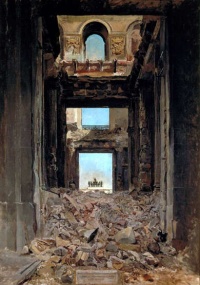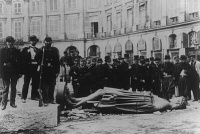Demolition
From The Art and Popular Culture Encyclopedia

|
Related e |
|
Featured: |
Demolition is the tearing-down of buildings and other structures. Demolition contrasts with deconstruction, which involves taking a building apart while carefully preserving valuable elements for re-use.
For small buildings, such as houses, that are only two or three stories high, demolition is a rather simple process. The building is pulled down either manually or mechanically using large hydraulic equipment: elevated work platforms, cranes, excavators or bulldozers. Larger buildings may require the use of a wrecking ball, a heavy weight on a cable that is swung by a crane into the side of the buildings. Wrecking balls are especially effective against masonry, but are less easily controlled and often less efficient than other methods. Newer methods may use rotational hydraulic shears and silenced rock-breakers attached to excavators to cut or break through wood, steel, and concrete. The use of shears is especially common when flame cutting would be dangerous.
The tallest building demolished by nonterrorist methods was the 47-story Singer Building in New York City, which was built in 1908 and torn down in 1967-1968 to be replaced by One Liberty Plaza.
See also
- Construction waste
- Demolition belt
- Demolition waste
- Excavator Ram guard (Protection of excavators used for demolition)
- House demolition (military tactic)
- ICE demolition protocol
- List of demolished buildings and structures in London
- National Federation of Demolition Contractors (UK)
- World Trade Center controlled demolition conspiracy theories



